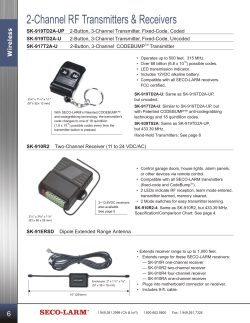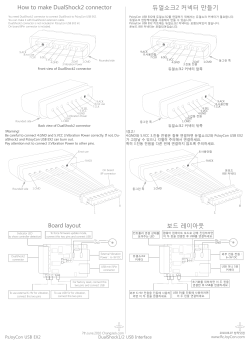
Application Note AN-00170 Replacing the KH2 Series with the KH3 Series Introduction
Replacing the KH2 Series with the KH3 Series Application Note AN-00170 Introduction With the discontinuation of the Holtek® encoders and decoders, the KH2 Series is also being discontinued. Linx has developed the KH3 Series as a replacement. The KH3 replaces the Holtek® parts with the Linx DS Series encoder / decoder. This offers full over-the-air compatibility and can be a drop-in replacement with most applications. There are some differences that can be applicable depending on how the modules are implemented in the system. Physical Difference The KH2 and KH3 Series are in the same package. The only physical differences are that the KH3 has no lid and three pins on one end. These pins are discussed later in this document. 1.430" 0.630" 1.211" RF RECEIVER/DECODER RXD-418-KH2 0.630" LOT 1000 RF TRANSMITTER/ENCODER TXE-418-KH2 LOT 10000 0.180" 0.180" Figure 1: KH2 Series Transmitter and Receiver Dimensions 1.21 in (30.73 mm) 1.43 in (36.32 mm) 0.63 in (16.00 mm) 0.63 in (16.00 mm) 0.106 in (2.69 mm) 0.106 in (2.69 mm) Figure 2: KH3 Series Transmitter and Receiver Dimensions –1– Application Note AN-00170 The physical size of the modules is the same, so the same PCB can be used with the new generation modules. The footprints of the KH3 Series have three pins on one of the ends of the module. As will be discussed later, these pins can be left floating, depending on the implementation of the modules. 0.065" 0.065" 0.610" 0.610" 0.070" 0.070" 0.100" 0.100" Figure 3: KH2 Series Transmitter and Receiver Footprints 0.07 in (1.78 mm) 0.065 in (1.65 mm) 0.053 in (1.35 mm) 0.096 in (2.44 mm) 0.10 in (2.54 mm) 0.10 in (2.54 mm) 0.274 in (6.96 mm) 0.07 in (1.78 mm) 0.61 in (15.49 mm) 0.065 in (1.65 mm) 0.046 in (1.17 mm) 0.096 in (2.44 mm) 0.10 in (2.54 mm) 0.14 in (3.56 mm) 0.10 in (2.54 mm) 0.274 in (6.96 mm) 0.14 in (3.56 mm) Figure 4: KH3 Series Transmitter and Receiver Footprints –2– Application Note AN-00170 0.61 in (15.49 mm) Electrical Difference The KH2 and KH3 Series have the same pin-out except for the three additional lines on the KH3 Series. NC D0 D1 GND VCC PDN D2 D3 D4 DATA VT D5 D6 D7 1 2 3 4 5 6 7 8 9 10 11 12 13 14 ANT GND NC RSSI A9 A8 A7 A6 A5 A4 A3 A2 A1 A0 28 27 26 25 24 23 22 21 20 19 18 17 16 15 1 2 3 4 5 6 7 8 9 10 11 12 LADJ/GND ANT D0 GND D1 A9 GND A8 VCC A7 TE A6 D2 A5 D3 A4 D4 A3 D5 A2 D6 A1 D7 A0 24 23 22 21 20 19 18 17 16 15 14 13 Figure 5: KH2 Series Transmitter and Receiver Pin-outs LADJ/GND ANT 24 2 D0 GND 27 2 D0 GND 23 3 D1 NC 26 4 GND RSSI 25 3 D1 A9 22 5 VCC A9 24 4 GND A8 21 6 PDN A8 23 5 VCC A7 20 7 D2 A7 22 6 TE A6 19 8 D3 A6 21 7 D2 A5 18 9 D4 A5 20 8 D3 A4 17 10 DATA A4 19 9 D4 A3 16 11 VT A3 18 12 D5 A2 17 10 D5 A2 15 13 D6 A1 16 11 D6 A1 14 14 D7 A0 15 12 D7 A0 13 29 30 31 25 26 27 D_CFG A_CFG1 1 A_CFG0 28 A_CFG1 ANT A_CFG0 NC D_CFG 1 Figure 6: KH3 Series Transmitter and Receiver Pin-outs –3– Application Note AN-00170 Functional Difference The difference between the KH2 Series and KH3 Series is that the Holtek® encoder and decoder are replaced by the DS Series encoder / decoder. The DS is specifically designed to be operable with previous generation products based on Holtek® encoders and decoders. The only exception is that the Holtek® encoders and decoders have tri-state input lines but the DS Series has bi-state lines. Tri-state inputs are connected to ground for zero bits, VCC for one bits, or left unconnected for open bits. The DS Series lines must be connected to ground or VCC; they cannot be left floating. Since the DS cannot match this operation the D_CFG, A_CFG0 and A_ CFG1 lines are provided to select the desired interpretation. The settings must match on both ends. Pulling the D_CFG line high configures the data bits as one and zero. A high on a data line on the transmitter is interpreted as a one bit and a low on the line is interpreted as a zero bit. Pulling D_CFG low configures the data bits as one and open. A high on a data line is interpreted as a one bit and a low on the line is interpreted as an open bit. The decoder outputs open data bits as logic low. D_CFG Configuration Configuration Bit Interpretation D_CFG High Low 0 One Open 1 One Zero Figure 7: D_CFG Configuration A_CFG0 and A_CFG1 are used to select the bit type for the address lines. A_CFGO and A_CFG1 Configuration Configuration Bit Interpretation A_CFG1 A_CFG0 High Low 0 0 One Zero 0 1 One Open 1 0 Open Zero 1 1 One Zero Figure 8: A_CFG0 and A_CFG1 Configuration D_CFG is pulled low internally so that a high on a data line is transmitted as a one bit and a low on the line is transmitted as an open bit. A_CFG0 is pulled low and A_CFG1 is pulled high internally so that a high on an address line is interpreted as an open bit and a low as a zero bit. The addition of these lines provides the maximum compatibility with the Holtek encoders and decoders, but does make full compatibility dependent on how the modules are implemented. –4– Application Note AN-00170 Most implementations follow our typical application circuit and connect the address lines to a DIP switch and the data lines to buttons. This makes the address lines either ground or floating while the data lines are either high or floating. VCC 1 GND 0 OHM 2 3 4 VCC GND 5 6 7 8 9 10 11 12 GND/LADJ ANT D0 GND D1 A9 GND A8 VCC A7 TE A6 D2 A5 D3 A4 D4 A3 D5 A2 D6 A1 D7 A0 24 23 22 GND 21 20 19 18 17 1 2 3 4 5 6 7 8 9 10 GND 16 15 14 13 TXE-xxx-KH2 100K GND Figure 9: KH2 Series Transmitter Typical Application Circuit The configuration lines on the KH3 match this implementation by default. This means that the KH3 can be placed on the same board used by the KH2 with the new lines left disconnected. No board changes are required. This also matches the implementation with the Linx handheld and keyfob remote controls. If the address lines are pulled to VCC or the button lines pulled to ground, then the configuration lines on the KH3 modules need to be set appropriately. This implementation requires a board change or modification. Addressing Differences The DS Series has a small modification with regards to addressing. The decoder does not recognize the case where all of the address lines are high or all are low. At least one address line must be different from the rest. This was implemented because many customers were using a default address with all switches set the same and had issues of crosstalk between different systems. Many cases this was a simple annoyance, but in some cases this represents a critical risk to safety. All customers are highly encouraged to set a unique address. –5– 20 19 18 17 16 15 14 13 12 11 Application Note AN-00170 It should be noted that the transmitter does send a command with all lines high or all low, but the receiver does not accept that as a valid address and ignores the transmission. Conclusion The creation of the KH3 Series allows existing customers a migration path to maintain functionality with existing deployed systems. There are some differences that could apply depending on the module’s implementation. Please contact Linx Technical Support with any questions or concerns. Copyright © 2014 Linx Technologies 159 Ort Lane, Merlin, OR 97532 Phone: +1 541 471 6256 Fax: +1 541 471 6251 www.linxtechnologies.com –6– Application Note AN-00170
© Copyright 2025















